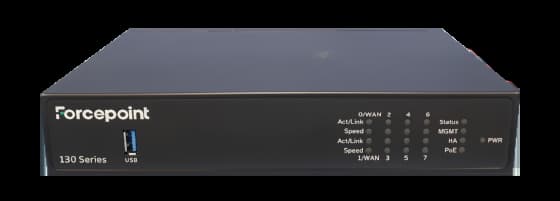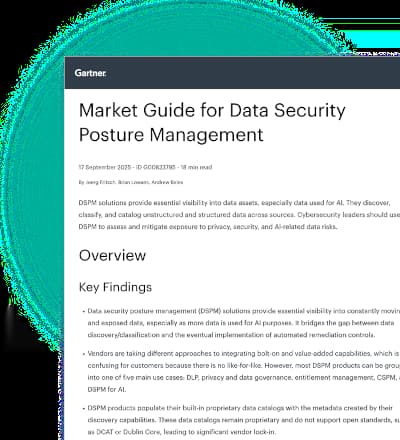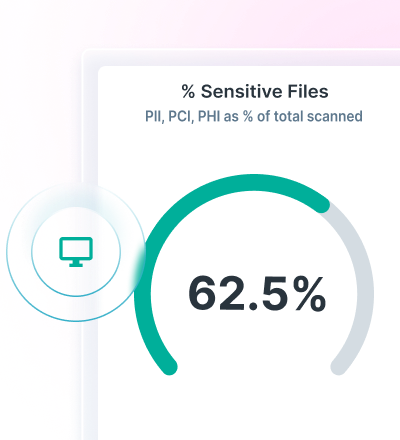
Oltre 12.000 clienti non possono sbagliarsi










































Scala e proteggi l'accesso di rete negli uffici, nelle filiali e nelle sedi remote.
Wide area networking = sicurezza. Forcepoint Secure SD-WAN protegge le reti dalle minacce avanzate con controlli di sicurezza zero-trust, garantendo al contempo una connettività superiore ovunque nel mondo.
Perché scegliere Forcepoint Secure SD-WAN?
Gestione centralizzata: attiva filiali, uffici e sedi remote dal cloud. Configura le policy una volta sola e utilizza la distribuzione zero-touch con Secure Management Console (SMC).
Miglioramento delle prestazioni applicative: riduci la latenza e il jitter e assicurati che le applicazioni critiche ricevano la priorità della banda tramite la connettività multi-link, il traffico dinamico, il monitoraggio dello stato e altre funzionalità.
Protezione dalle minacce avanzate: rileva e previeni i rischi grazie alle funzionalità di ispezione multilivello e di prevenzione delle intrusioni, il mantenimento dei sink DNS e altro ancora, proteggendo al contempo l'accesso alle applicazioni on-site o remote tramite il connettore per applicazioni ZTNA.
Riduzione dei costi operativi: taglia i costi di rete e migliora l'affidabilità con le operazioni di combinazione e corrispondenza in tempo reale della selezione di banda larga ISP locale e MPLS privato.
Scheda dati
Confronto dei modelli di appliance


Global Network
20+
Countries
45+
Cluster Nodes
Clustering In a Way No One Else Can Do
Christian Keller, CISO at Huber + Suhner, lists reliability, clustering, and ability to navigate global compliance requirements among the top benefits of Forcepoint NGFW.
Scopri i modelli di Forcepoint Secure SD-WAN

Serie 3500
Ideale per grandi imprese, reti di campus e data center.
Fino a 66 interfacce
Throughput firewall fino a 600 Gbps
Throughput NGFW IPS fino a 140 Gbps

Serie 3400
Ideale per reti di campus e data center.
Fino a 67 interfacce
Throughput firewall fino a 200-300 Gbps
Throughput NGFW IPS fino a 15-35 Gbps

Serie 2200
Ideale per uffici di medie e grandi dimensioni.
Fino a 25 interfacce
Throughput firewall fino a 120 Gbps
Throughput NGFW IPS fino a 13,5 Gbps

Serie 1200
Ideale per uffici di medie e grandi dimensioni.
Fino a 17 interfacce
Throughput firewall fino a 65 Gbps
Throughput NGFW IPS fino a 5 Gbps

Serie 350
Ideale per siti remoti e filiali (design desktop).
Fino a 13 interfacce
Throughput firewall di 40 Gbps
Throughput NGFW IPS da 2 Gbps (N352) o 4.1 Gbps (N355)

Serie 130
Ideal for remote offices, branches and stores.
Fino a 8 interfacce
Throughput del firewall 8 Gbps
Throughput IPS NGFW 1,600 Mbps

Serie 120
Ideale per sedi fisiche e filiali.
Fino a 8 interfacce
Throughput firewall di 4 Gbps
Throughput NGFW IPS di 450 Mbps

Serie 60
Ideale per uffici remoti, filiali e sedi fisiche.
Fino a 4 interfacce
Throughput firewall di 2 Gbps
Throughput NGFW IPS di 350 Mbps
Immagini cloud:
- Software Forcepoint NGFW unificato
- Amazon Web Services (AWS)
- Soluzioni Microsoft Azure
- Protegge le comunicazioni nord-sud in ingresso/uscita dal cloud e il traffico SDN est-ovest
Appliance virtuali:
- Software Forcepoint NGFW unificato
- Disponibili per KVM e VMware ESXi ed NSX
- Scalabile fino a 64 CPU
- Automatizza la microsegmentazione di rete
- Consente il clustering con firewall fisici


Secure SD-WAN - Guida all'acquisto
Che tu stia acquistando una soluzione per la prima volta o stia valutando un upgrade, la nostra guida include tutte le informazioni chiave per aiutarti a valutare le diverse soluzioni Secure SD-WAN. Scopri le cinque considerazioni chiave da tenere a mente.
Perché i clienti scelgono SD-WAN
Perché i clienti scelgono SD-WAN
"Our costs - both for the project and maintenance - are going down because we don't need resources locally, we have centralized everything. If we want new service on a train, we define the policy then give the hardware to the operator, who installs it."
VR Group
Frequently Asked Questions
What is managed SD-WAN?
A managed SD-WAN is a service where a provider handles the deployment, configuration, monitoring and optimisation of your WAN. Meanwhile, a cloud-managed SD-WAN adds centralised control via the cloud, making it easier to apply consistent policies, improve performance and maintain security across distributed networks without internal resource strain. Learn more about this product through our comprehensive managed SD-WAN solutions guide.
What are the benefits of SD-WAN?
Benefits of Forcepoint Secure SD-WAN include the following:
Centralized management
Improved application performance
Protection against advanced threats
Reduced operating costs
How much does SD-WAN cost?
SD-WAN costs are determined by factors, including the type of deployment, the size of the network, the number of locations to connect, the type and amount of data transiting the network and any existing infrastructure that may be leveraged when deploying an SD-WAN solution.
What is SD-WAN security?
SD-WAN security helps organizations enable effortless connection to cloud resources while protecting users, data and IT environments from attack.
What is an SD-WAN solution?
Ad SD-WAN solution applies software-defined networking principles to the wide area network.
What is an SD-WAN provider?
SD-WAN providers enable organizations to deploy SD-WAN technology.
What is an SD-WAN appliance?
SD-WAN appliances are physical or virtual controllers located on-premises or in the cloud that connect an organization’s users to applications, services and workloads.
How do SD-WAN appliances work?
SD-WAN appliances and products are designed to overcome the challenges of ensuring fast and secure connectivity for branch locations and hybrid workforces. The traditional wide area network uses a hub-and-spoke model that requires all traffic to flow through a central data center. For organizations with a highly distributed workforce, this model adds unacceptable levels of latency that negatively affect user experiences and productivity. Additionally, legacy WANs are built with costly Multiprotocol Label Switching (MPLS) connections that are time-consuming to manage and deploy, preventing organizations from scaling easily and cost-efficiently. SD-WAN overcomes these issues by creating a virtual overlay for the network that abstracts network connections and enables the use of additional, low-cost transport services that add redundancy and flexibility.
What is Multiprotocol Label Switching (MPLS)?
Multiprotocol Label Switching (MPLS) is data forwarding technology that increases the speed and controls the flow of network traffic.
What is SD-WAN vs MPLS?
SD-WAN is a networking technology that uses software to make wide area networks more intelligent and flexible by connecting sites directly to the internet over commodity broadband links. Configurations and access policies are centrally managed and easily applied across all sites, removing the need to manual administer each WAN device individually. MPLS is data forwarding technology for network traffic that directs data through a path via labels instead of requiring complex lookups in a routing table at every stop. Traditional networking technology, MPLS, has seen competition from SD-WAN solutions to meet today's high demands and expanding needs for networked business-critical systems.










